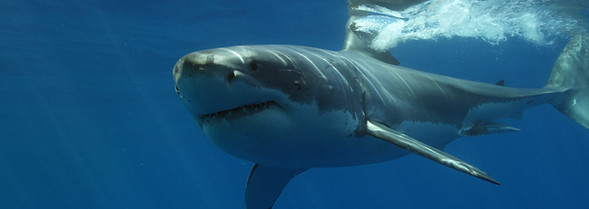
explore the Natural world

Scroll to Learn
Biology
Great white sharks are a species of mackerel shark, and can be found along the coast in all major oceans. They're around 13 to 20 feet long (4 to 5.8 meters) or smaller, and can live for an estimated 70 years or longer! They can swim around 16 mph (25 km/h) for short periods, and dive as low as 3,900 ft (1,200 meters) in the water. These sharks have a reputation for being big, scary, and dangerous; and while they are some of the largest predators in the ocean, their danger to human divers has been greatly exaggerated over the years.

Great white sharks explore the world with their mouths. Lacking hands of any kind, they tend to bite first to understand what they've come into contact with. They do have an organ that helps them sense elecromagentic fields around living animals, but they're not the best at understanding what it is they're seeing. They're not trying to eat whatever it is they've found, so they don't put much force into it - but with that said, since humans are relatively very soft, even these "exploratory" bites can be dangerous. This behavior of mouthing whatever they find has lead to a very high bite-count on humans, and has earned them a poor reputation. In reality, they appear to dislike the taste of humans and will avoid attacking us once they know what we are.
There's a lot more to great white sharks than just their biting habits, though! Their social structure is complex, to the point where they often meet up and share information about hunting spots. Clans of sharks may range from just 2 to 6 individuals. They are highly curious, able to create complicated hunting strategies, and even regularly lift their heads to look over the water! Clearly, they are far more interesting than their reputation as mindless eating machines. Just like whales and dolphins, sharks are intelligent, amazing animals, and they deserve our respect - not our fear.

